
The following information is current as of November 19, 2008. Eagle Rock plans to provide updates to
this information whenever material changes are made to its commodity derivative portfolio.
this information whenever material changes are made to its commodity derivative portfolio.
Commodity Hedging Overview
November 19, 2008
November 19, 2008

The material that follows may include “forward-looking statements” within the meaning of
Section 27A of the Securities Act of 1933, as amended, and Section 21E of the Securities
Exchange Act of 1934, as amended. All statements, other than statements of historical
facts, included in this material that address activities, events or developments that the
Partnership expects, believes or anticipates will or may occur in the future are forward-
looking statements. These statements are based on certain assumptions made by the
Partnership based on its experience and perception of historical trends, current conditions,
expected future developments and other factors it believes are appropriate under the
circumstances. Such statements are subject to a number of assumptions, risks and
uncertainties, many of which are beyond the control of the Partnership, which may cause
the Partnership’s actual results to differ materially from those implied or expressed by the
forward-looking statements. For a detailed list of the Partnership’s risk factors, please
consult the Partnership’s Form 10-K, filed with the Securities and Exchange Commission
for the year ended December 31, 2007, and the Partnership’s Forms 10-Q, filed with the
SEC for subsequent quarters.
Section 27A of the Securities Act of 1933, as amended, and Section 21E of the Securities
Exchange Act of 1934, as amended. All statements, other than statements of historical
facts, included in this material that address activities, events or developments that the
Partnership expects, believes or anticipates will or may occur in the future are forward-
looking statements. These statements are based on certain assumptions made by the
Partnership based on its experience and perception of historical trends, current conditions,
expected future developments and other factors it believes are appropriate under the
circumstances. Such statements are subject to a number of assumptions, risks and
uncertainties, many of which are beyond the control of the Partnership, which may cause
the Partnership’s actual results to differ materially from those implied or expressed by the
forward-looking statements. For a detailed list of the Partnership’s risk factors, please
consult the Partnership’s Form 10-K, filed with the Securities and Exchange Commission
for the year ended December 31, 2007, and the Partnership’s Forms 10-Q, filed with the
SEC for subsequent quarters.
As of November 19, 2008
1
Disclosure Regarding “Forward-looking Statements”

• Hedging Objectives
• Hedging Processes and Controls
– Risk Management Policy
– Risk Management Committee
– Internal Controls
• Hedging Methods
– Commodities Hedged
– Quantities Hedged
– Types of Derivatives Used
• Special Issues
– Use of Cross-commodity Hedges
– Midstream Segment’s Short Natural Gas Position
• Derivative Portfolio
•Settlement Sensitivity Curves
As of November 19, 2008
2
Table of Contents

• Eagle Rock’s primary business objective is to manage its assets to create stable and
growing distributions to its unitholders.
growing distributions to its unitholders.
• Eagle Rock’s management recognizes that commodity price volatility can cause
significant changes in distributable cash flow, and these changes can affect our
ability to achieve our distribution objective.
significant changes in distributable cash flow, and these changes can affect our
ability to achieve our distribution objective.
• Therefore, Eagle Rock’s management has concluded that it is appropriate for Eagle
Rock to engage in non-speculative hedging activities to reduce the impact that future
changes in commodity prices might have on distributable cash flow.
Rock to engage in non-speculative hedging activities to reduce the impact that future
changes in commodity prices might have on distributable cash flow.
• Eagle Rock’s management has also concluded that it is necessary to hedge a
substantial portion of its expected future production in order to meaningfully reduce
its future distributable cash flow volatility.
substantial portion of its expected future production in order to meaningfully reduce
its future distributable cash flow volatility.
•Eagle Rock recognizes, however, that hedging 100% of its future expected
production would be imprudent. It generally limits its hedging levels to 80% of
expected future production (excluding the special case of natural gas and ethane),
although hedging at this level does not eliminate all of the volatility in our
distributable cash flow. The reason for hedging at this level is that Eagle Rock wants
to avoid a situation where a loss of production would put it in an “over-hedged”
position.
production would be imprudent. It generally limits its hedging levels to 80% of
expected future production (excluding the special case of natural gas and ethane),
although hedging at this level does not eliminate all of the volatility in our
distributable cash flow. The reason for hedging at this level is that Eagle Rock wants
to avoid a situation where a loss of production would put it in an “over-hedged”
position.
3
As of November 19, 2008
Hedging Objectives

• Eagle Rock has a Risk Management Policy that has been approved by its Board of
Directors and is amended from time to time.
Directors and is amended from time to time.
• The Risk Management Policy addresses the following -
– Management’s authority to conduct hedging activities,
– The establishment and responsibilities of the Risk Management Committee,
– Allowable hedging levels, including the maximum amount of hedging that can be
conducted in a single quarter,
conducted in a single quarter,
– Prohibition against speculation, and
– Requirement to provide quarterly reporting to the Board of Directors.
* Throughout this presentation, “Board of Directors” refers to the Board of Directors of the general partner of the general partner of the Partnership.
As of November 19, 2008
4
Hedging Processes and Controls
Risk Management Policy
Risk Management Policy

• The Risk Management Committee is currently comprised of the following - -
– Chief Executive Officer
– Chief Financial Officer
– Senior Vice President, Corporate Development
– Senior Vice President, Technical Evaluations
– Senior Vice President, Midstream
– Senior Vice President, Chief Compliance Officer, Secretary and General Counsel
– Vice President, Marketing
– Vice President, Investor Relations and Treasurer
– Vice President, Financial Reporting
• The Risk Management Committee has a regular monthly meeting, but also holds additional
meetings as needed.
meetings as needed.
• The Risk Management Committee is the forum where hedging transactions are evaluated
and discussed. The committee also draws on the expertise of other Eagle Rock employees
and third party consultants.
and discussed. The committee also draws on the expertise of other Eagle Rock employees
and third party consultants.
As of November 19, 2008
5
Hedging Processes and Controls
Risk Management Committee
Risk Management Committee

• Eagle Rock maintains extensive internal controls to ensure the proper execution, valuation and
reporting of derivative transactions.
reporting of derivative transactions.
• As part of these controls, Eagle Rock has segregated various duties:
– Hedging recommendation - Risk Management Committee
– Trade execution - SVP, Corporate Development
– Trade witnessing and entry - 3d party risk management consultant
– Valuation - VP, Financial Reporting
– Settlement - VP, Treasurer
• Eagle Rock uses the Kiodex system to record and value derivative positions.
• In addition, Eagle Rock’s internal and external auditors routinely test various hedging-related
controls.
controls.
• The Board of Directors establishes the maximum hedging levels and the maximum amount of
hedging that can be conducted in a given quarter. These limits can be exceeded with Board
approval, however.
hedging that can be conducted in a given quarter. These limits can be exceeded with Board
approval, however.
• The Audit Committee of the Board of Directors and the full Board receive a hedging update each
quarter at their regular meetings.
quarter at their regular meetings.
• In practice, all large hedging transactions are discussed with the Board of Directors, even if the
Risk Management Policy does not specifically require it.
Risk Management Policy does not specifically require it.
As of November 19, 2008
6
Hedging Processes and Controls
Internal Controls
Internal Controls

• Eagle Rock bases its volumes available for hedging on its expected future production.
• For the Upstream and Minerals businesses, the expected future production is derived from the
proved reserves.
proved reserves.
– The proved reserves quantities are adjusted downwards to account for price-dependent expenses
and revenue reductions.
and revenue reductions.
– Specifically, they are reduced to account for the volumes needed to pay state severance taxes and to
make the Exxon Retained Revenue Interest payments (see SEC filings for more information on the
Exxon Retained Revenue Interest).
make the Exxon Retained Revenue Interest payments (see SEC filings for more information on the
Exxon Retained Revenue Interest).
• For the Midstream business, the volumes available for hedging are based on the expected future
production of the wells currently flowing to our processing plants, plus additional volumes that we
expect to receive from future drilling.
production of the wells currently flowing to our processing plants, plus additional volumes that we
expect to receive from future drilling.
– Eagle Rock’s expectations for volumes from future drilling are based on information it receives from
the operators and its historical observations.
the operators and its historical observations.
– To these projections, it applies various contract terms to determine its equity share of the
commodities.
commodities.
• In the cases where one commodity is hedged with a closely-correlated commodity (which Eagle
Rock calls “cross-commodity hedging”), such as using crude oil to hedge natural gas liquids, Eagle
Rock converts the expected volumes of the underlying commodity to equivalent volumes of the
hedged commodity.
Rock calls “cross-commodity hedging”), such as using crude oil to hedge natural gas liquids, Eagle
Rock converts the expected volumes of the underlying commodity to equivalent volumes of the
hedged commodity.
– The conversions are based on the linear regression of the prices of the two commodities observed
during the previous 36 months.
during the previous 36 months.
As of November 19, 2008
7
Commodity Hedging Methods
Quantities Hedged
Quantities Hedged

• Eagle Rock generally uses put options, costless collars, and fixed price swaps to
achieve its hedging objectives. There are other hedging strategies that use more than
two options; however, Eagle Rock is not currently utilizing these more complex
strategies.
achieve its hedging objectives. There are other hedging strategies that use more than
two options; however, Eagle Rock is not currently utilizing these more complex
strategies.
• Put options provide price protection below the strike price, while maintaining
exposure to higher future prices. They require the payment of a “premium” which
may or may not be recovered, depending on future prices.
exposure to higher future prices. They require the payment of a “premium” which
may or may not be recovered, depending on future prices.
• Costless collars are a hedging strategy that uses two options: a long put and a short
call. The put establishes a “floor” price and provides downside price protection. The
call has a higher strike price than the put, and is sold to offset the cost of the put.
The call limits exposure to future prices that exceed its strike price, however.
Between the two strike prices, the owner of the position is exposed to changes in
prices.
call. The put establishes a “floor” price and provides downside price protection. The
call has a higher strike price than the put, and is sold to offset the cost of the put.
The call limits exposure to future prices that exceed its strike price, however.
Between the two strike prices, the owner of the position is exposed to changes in
prices.
• Fixed price swaps provide the swap holder with a fixed price, regardless of future
prices.
prices.
• Eagle Rock considers its expected future production, its current hedge portfolio,
current forward pricing, quoted option prices, and other factors to determine which
types of derivatives to use at a given time.
current forward pricing, quoted option prices, and other factors to determine which
types of derivatives to use at a given time.
As of November 19, 2008
8
Commodity Hedging Methods
Types of Derivatives Used
Types of Derivatives Used

• When applicable, Eagle Rock has hedged its future volumes with derivatives that are based on the
same commodity. In some cases, however, Eagle Rock believes it is better to hedge future changes
in the price of one commodity with a derivative of another commodity. Eagle Rock refers to these
as “cross-commodity” hedges.
same commodity. In some cases, however, Eagle Rock believes it is better to hedge future changes
in the price of one commodity with a derivative of another commodity. Eagle Rock refers to these
as “cross-commodity” hedges.
• Eagle Rock often hedges the changes in future NGL prices (propane and heavier) using crude oil
hedges. It has adopted this practice based on the following observations:
hedges. It has adopted this practice based on the following observations:
– Historically, NGL prices have been highly correlated to crude oil prices.
– NGL forward prices are often quoted at a discount to crude oil forward prices. In some instances,
depending on the NGL component and the time period, the discounts can be very significant and
unattractive.
depending on the NGL component and the time period, the discounts can be very significant and
unattractive.
• Eagle Rock also uses natural gas hedges to hedge a portion of its expected future ethane
production.
production.
– The rationale for this practice is that the forward curve for ethane is often severely discounted from
current prices. Also, natural gas prices provide support to ethane prices because in many processing
plants ethane can be recombined with the residue gas stream and sold as natural gas.
current prices. Also, natural gas prices provide support to ethane prices because in many processing
plants ethane can be recombined with the residue gas stream and sold as natural gas.
– For the purpose of determining the volumes of ethane available to hedge with natural gas, Eagle
Rock uses the thermal content of ethane (measured in mmbtu/gallon).
Rock uses the thermal content of ethane (measured in mmbtu/gallon).
As of November 19, 2008
9
Special Issues
Use of Cross-commodity Hedges
Use of Cross-commodity Hedges

• Eagle Rock’s Midstream business has a long and a short physical position in its expected future
natural gas production streams.
natural gas production streams.
• The long position is derived from its “percent-of-proceeds” contracts. Under these agreements,
Eagle Rock keeps a percentage of the residue gas and natural gas liquids that are sold from the
plants it owns.
Eagle Rock keeps a percentage of the residue gas and natural gas liquids that are sold from the
plants it owns.
• The short position is derived from its “keep-whole” and “fixed-recovery” processing contracts.
Under these arrangements, Eagle Rock keeps all of the natural gas liquids it extracts from the gas
stream that producers deliver to us, but it must pay the producers for the shrinkage that occurs to
their gas stream as a result of processing.
Under these arrangements, Eagle Rock keeps all of the natural gas liquids it extracts from the gas
stream that producers deliver to us, but it must pay the producers for the shrinkage that occurs to
their gas stream as a result of processing.
• The gas streams that are processed under percent-of-proceeds and keep-whole arrangements are
generally independent of each other. Therefore, as the performance of wells changes, and as Eagle
Rock acquires new sources of supply for processing, the expected future volumes of the long
natural gas and short natural gas positions can change.
generally independent of each other. Therefore, as the performance of wells changes, and as Eagle
Rock acquires new sources of supply for processing, the expected future volumes of the long
natural gas and short natural gas positions can change.
• These changes, combined with the long natural gas position in our Upstream and Minerals
segments, can result in changes to Eagle Rock’s exposure to changes in natural gas prices.
segments, can result in changes to Eagle Rock’s exposure to changes in natural gas prices.
• Including the effect of its natural gas hedge position, Eagle Rock attempts to maintain a small, net
long natural gas position.
long natural gas position.
As of November 19, 2008
10
Special Issues
Midstream Business Short Natural Gas Position
Midstream Business Short Natural Gas Position

• Eagle Rock has prepared a summary of its commodity derivative portfolio as of
November 1, 2008.
November 1, 2008.
• In some cases, Eagle Rock entered into transactions to offset previous transactions.
In the cases where the offsetting transaction was an exact match to the original
transaction (i.e., same underlying, quantity, time period and strike price), neither the
original nor the offsetting transaction are shown.
In the cases where the offsetting transaction was an exact match to the original
transaction (i.e., same underlying, quantity, time period and strike price), neither the
original nor the offsetting transaction are shown.
• Most of Eagle Rock’s derivative transactions have a constant quantity each month,
but a few do not. On the following table, for those that have varying monthly
quantities, the average monthly quantity is shown. These values are highlighted in
bold italics.
but a few do not. On the following table, for those that have varying monthly
quantities, the average monthly quantity is shown. These values are highlighted in
bold italics.
As of November 19, 2008
11
Derivative Portfolio

• Eagle Rock has prepared several curves that illustrate the settlements that would be
received in 2009 under various assumed future prices, given its current commodity
hedge portfolio.
received in 2009 under various assumed future prices, given its current commodity
hedge portfolio.
• The curves are presented by underlying commodity.
• For each curve,
– the settlements are shown on the Y-axis in $ millions.
– The assumed future prices are shown on the X-axis. To calculate the settlements, it
was assumed that these prices were constant for the entire calendar year.
was assumed that these prices were constant for the entire calendar year.
• The curves do not reflect the revenues derived from the sale of the underlying
physical commodities.
physical commodities.
As of November 19, 2008
12
2009 Hedge Settlement Sensitivity Curves
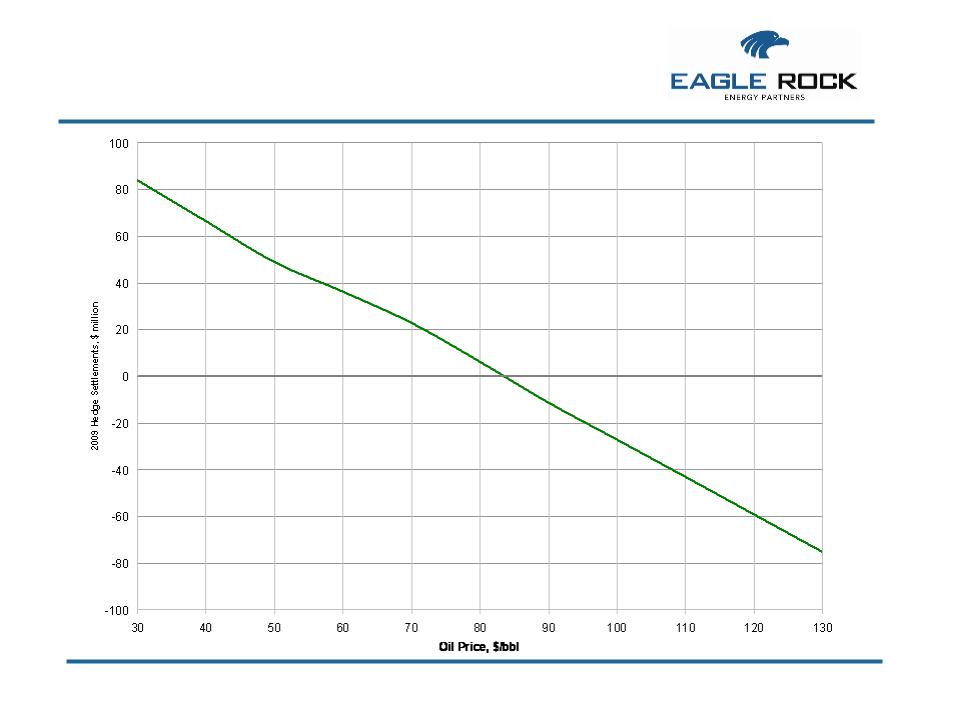
As of November 19, 2008
13
2009 Crude Hedge Settlements
Assumes flat prices
Assumes flat prices
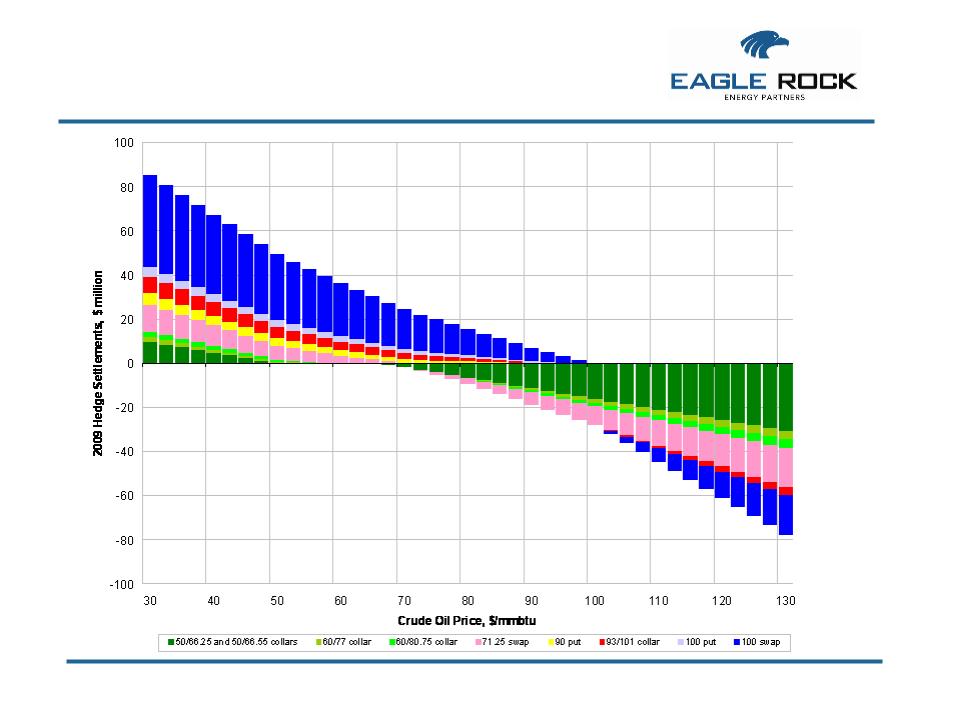
As of November 19, 2008
14
2009 Crude Hedge Settlements - Detailed
Assumes flat prices
Assumes flat prices
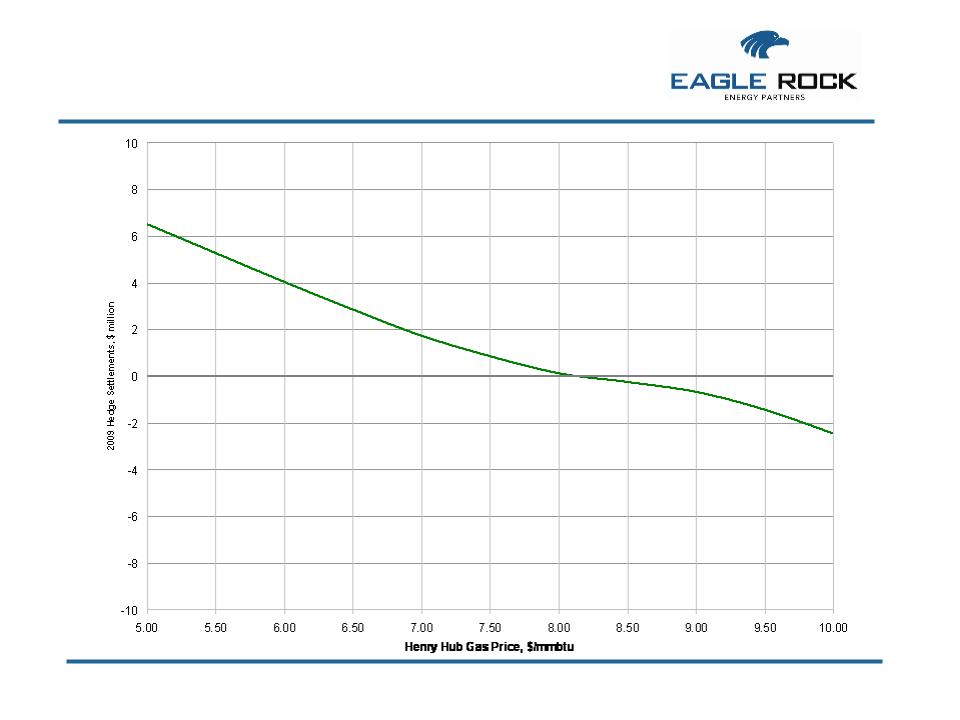
As of November 19, 2008
15
2009 Henry Hub Gas Hedge Settlements
Assumes flat prices
Assumes flat prices
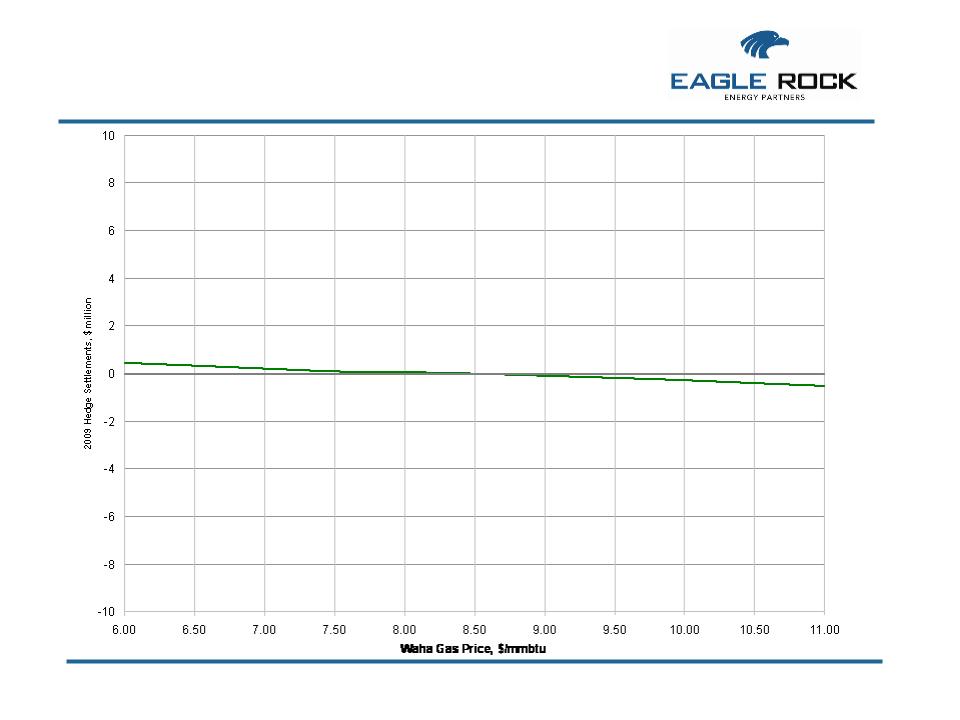
As of November 19, 2008
16
2009 Waha Gas Hedge Settlements
Assumes flat prices
Assumes flat prices
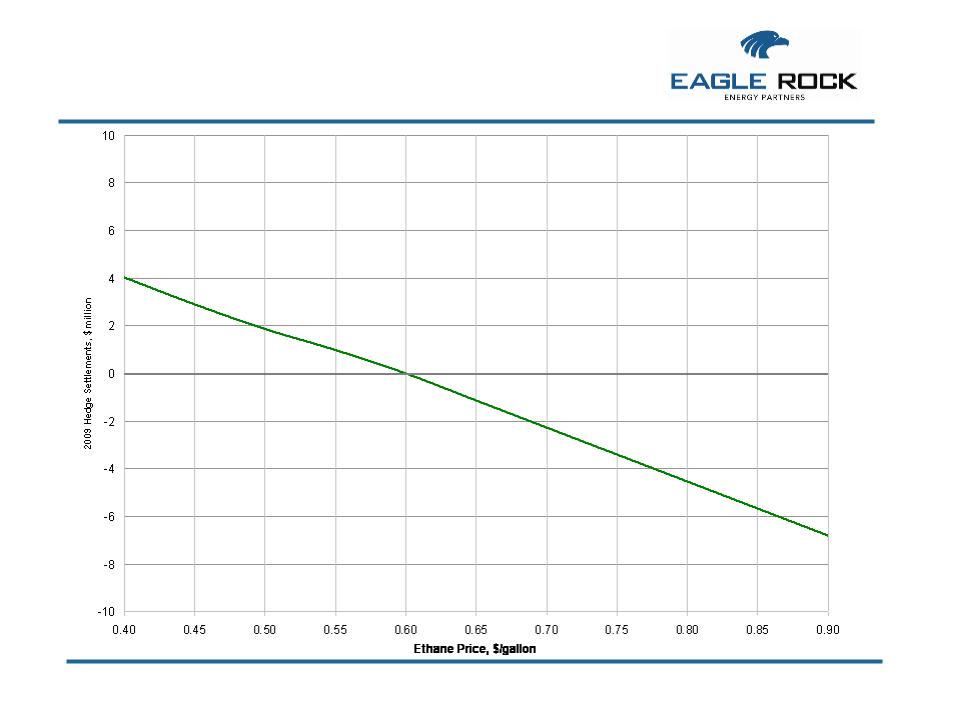
As of November 19, 2008
17
2009 OPIS Ethane Hedge Settlements
Assumes flat prices
Assumes flat prices
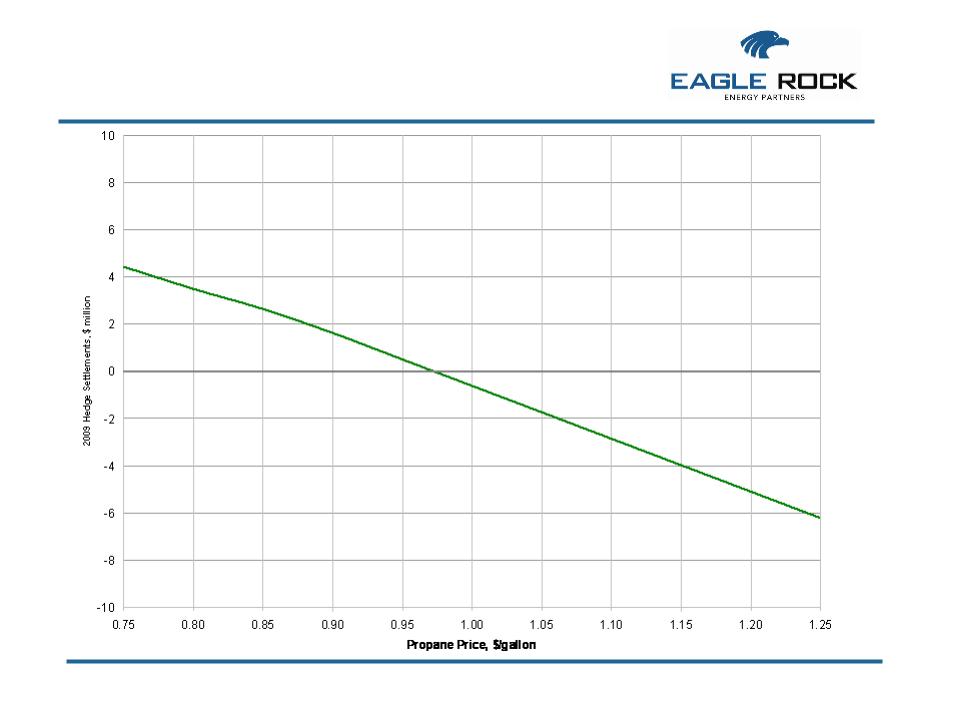
As of November 19, 2008
18
2009 OPIS Propane Hedge Settlements
Assumes flat prices
Assumes flat prices
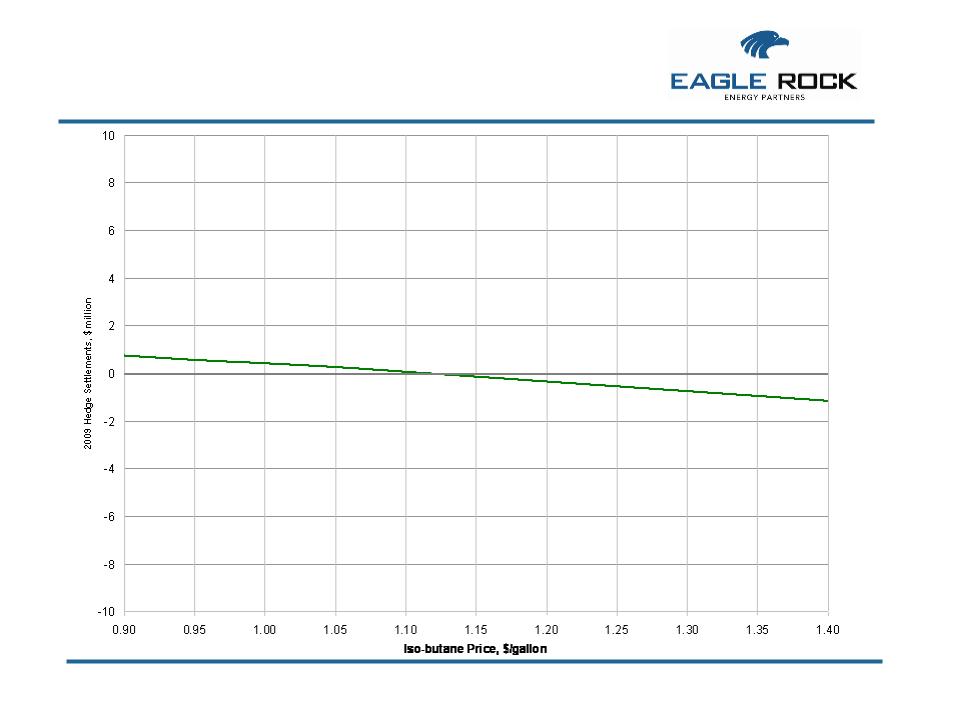
As of November 19, 2008
19
2009 OPIS Iso Butane Hedge Settlements
Assumes flat prices
Assumes flat prices
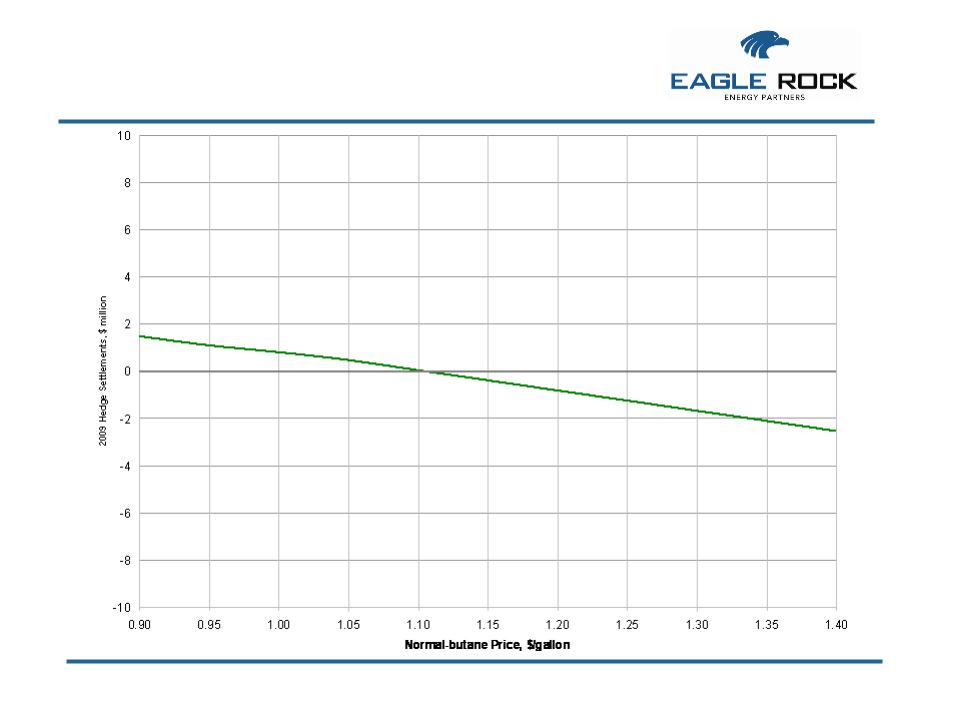
As of November 19, 2008
20
2009 OPIS Normal Butane Hedge Settlements
Assumes flat prices
Assumes flat prices
Eagle Rock Energy Partners Commodity Hedge Portfolio
11/1/2008
11/1/2008
| term | monthly | |||||||||
| year | underlying | type | start | end | quantity | floor price | ceiling price | months | total quantity | units |
| 2008 | IF Houston Ship Channel | put | Nov-08 | Dec-08 | 40,000 | 7.00 | 2 | 80,000 | mmbtu | |
| 2008 | IF Waha | costless collar | Nov-08 | Dec-08 | 20,000 | 8.50 | 9.45 | 2 | 40,000 | mmbtu |
| 2008 | NYMEX Henry Hub | costless collar | Nov-08 | Dec-08 | 30,000 | 6.25 | 11.15 | 2 | 60,000 | mmbtu |
| 2008 | NYMEX Henry Hub | costless collar | Nov-08 | Dec-08 | 30,000 | 7.50 | 12.01 | 2 | 60,000 | mmbtu |
| 2008 | NYMEX Henry Hub | costless collar | Nov-08 | Dec-08 | 103,000 | 7.00 | 13.75 | 2 | 206,000 | mmbtu |
| 2008 | NYMEX Henry Hub | costless collar | Nov-08 | Dec-08 | (103,000) | 8.25 | 13.75 | 2 | (206,000) | mmbtu |
| 2008 | NYMEX Henry Hub | put | Nov-08 | Dec-08 | 10,000 | 7.00 | 2 | 20,000 | mmbtu | |
| 2008 | NYMEX Henry Hub | swap | Nov-08 | Dec-08 | 83,000 | 8.00 | 2 | 166,000 | mmbtu | |
| 2008 | NYMEX WTI | call | Nov-08 | Dec-08 | (20,000) | 63.95 | 2 | (40,000) | bbls | |
| 2008 | NYMEX WTI | call | Nov-08 | Dec-08 | 20,000 | 65.65 | 2 | 40,000 | bbls | |
| 2008 | NYMEX WTI | costless collar | Nov-08 | Dec-08 | 6,000 | 60.00 | 71.65 | 2 | 12,000 | bbls |
| 2008 | NYMEX WTI | costless collar | Nov-08 | Dec-08 | 5,000 | 60.00 | 83.75 | 2 | 10,000 | bbls |
| 2008 | NYMEX WTI | costless collar | Nov-08 | Dec-08 | 4,000 | 60.00 | 77.20 | 2 | 8,000 | bbls |
| 2008 | NYMEX WTI | costless collar | Nov-08 | Dec-08 | 29,000 | 65.00 | 90.00 | 2 | 58,000 | bbls |
| 2008 | NYMEX WTI | costless collar | Nov-08 | Dec-08 | 11,500 | 95.00 | 105.20 | 2 | 23,000 | bbls |
| 2008 | NYMEX WTI | put | Nov-08 | Dec-08 | 6,000 | 65.00 | 2 | 12,000 | bbls | |
| 2008 | NYMEX WTI | put | Nov-08 | Dec-08 | 10,000 | 60.00 | 2 | 20,000 | bbls | |
| 2008 | NYMEX WTI | put | Nov-08 | Dec-08 | 4,000 | 90.00 | 2 | 8,000 | bbls | |
| 2008 | NYMEX WTI | swap | Nov-08 | Dec-08 | 80,000 | 100.00 | 2 | 160,000 | bbls | |
| 2008 | NYMEX WTI | swap | Nov-08 | Dec-08 | 30,000 | 89.50 | 2 | 60,000 | bbls | |
| 2008 | OPIS Ethane Mt Belv non TET | costless collar | Nov-08 | Dec-08 | 357,000 | 0.5500 | 0.6500 | 2 | 714,000 | gallons |
| 2008 | OPIS Ethane Mt Belv non TET | put | Nov-08 | Dec-08 | 96,600 | 0.8500 | 2 | 193,200 | gallons | |
| 2008 | OPIS Ethane Mt Belv non TET | swap | Nov-08 | Dec-08 | 357,000 | 0.6000 | 2 | 714,000 | gallons | |
| 2008 | OPIS Ethane Mt Belv non TET | swap | Nov-08 | Dec-08 | 1,050,000 | 0.7200 | 2 | 2,100,000 | gallons | |
| 2008 | OPIS IsoButane Mt Belv non TET | swap | Nov-08 | Dec-08 | 135,408 | 1.2950 | 2 | 270,816 | gallons | |
| 2008 | OPIS NButane Mt Belv non TET | swap | Nov-08 | Dec-08 | 269,115 | 1.2775 | 2 | 538,230 | gallons | |
| 2008 | OPIS Propane Mt Belv non TET | swap | Nov-08 | Dec-08 | 1,470,000 | 1.1900 | 2 | 2,940,000 | gallons | |
| 2008 | OPIS Propane Mt Belv non TET | swap | Nov-08 | Dec-08 | 199,269 | 1.0775 | 2 | 398,538 | gallons | |
| 2008 | OPIS Propane Mt Belv non TET | swap | Nov-08 | Dec-08 | 176,736 | 1.0875 | 2 | 353,472 | gallons | |
| 2009 | IF Waha | costless collar | Jan-09 | Mar-09 | 20,000 | 9.00 | 9.85 | 3 | 60,000 | mmbtu |
| 2009 | IF Waha | costless collar | Apr-09 | Jun-09 | 20,000 | 7.50 | 7.95 | 3 | 60,000 | mmbtu |
| 2009 | IF Waha | costless collar | Jul-09 | Sep-09 | 20,000 | 7.50 | 8.60 | 3 | 60,000 | mmbtu |
| 2009 | IF Waha | costless collar | Oct-09 | Dec-09 | 20,000 | 7.50 | 8.90 | 3 | 60,000 | mmbtu |
| 2009 | NYMEX Henry Hub | costless collar | Jan-09 | Mar-09 | 92,700 | 7.00 | 13.75 | 3 | 278,100 | mmbtu |
| 2009 | NYMEX Henry Hub | costless collar | Jan-09 | Mar-09 | (92,700) | 8.80 | 13.75 | 3 | (278,100) | mmbtu |
| 2009 | NYMEX Henry Hub | costless collar | Jan-09 | Dec-09 | 20,000 | 6.25 | 11.20 | 12 | 240,000 | mmbtu |
| 2009 | NYMEX Henry Hub | costless collar | Jan-09 | Dec-09 | 85,000 | 7.85 | 9.25 | 12 | 1,020,000 | mmbtu |
| 2009 | NYMEX Henry Hub | put | Jan-09 | May-09 | 40,000 | 7.00 | 5 | 200,000 | mmbtu | |
| 2009 | NYMEX Henry Hub | swap | Jan-09 | Dec-09 | 85,000 | 8.35 | 12 | 1,020,000 | mmbtu | |
| 2009 | NYMEX WTI | costless collar | Jan-09 | Dec-09 | 20,000 | 50.00 | 66.25 | 12 | 240,000 | bbls |
| 2009 | NYMEX WTI | costless collar | Jan-09 | Dec-09 | 20,000 | 50.00 | 66.55 | 12 | 240,000 | bbls |
| 2009 | NYMEX WTI | costless collar | Jan-09 | Dec-09 | 6,000 | 60.00 | 77.00 | 12 | 72,000 | bbls |
| 2009 | NYMEX WTI | costless collar | Jan-09 | May-09 | 7,000 | 60.00 | 80.75 | 5 | 35,000 | bbls |
| 2009 | NYMEX WTI | costless collar | Jan-09 | Dec-09 | 10,000 | 93.00 | 100.85 | 12 | 120,000 | bbls |
| 2009 | NYMEX WTI | put | Jan-09 | Dec-09 | 7,000 | 90.00 | 12 | 84,000 | bbls | |
| 2009 | NYMEX WTI | put | Jan-09 | Dec-09 | 5,000 | 100.00 | 12 | 60,000 | bbls | |
| 2009 | NYMEX WTI | swap | Jan-09 | Dec-09 | 25,000 | 71.25 | 12 | 300,000 | bbls | |
| 2009 | NYMEX WTI | swap | Jan-09 | Dec-09 | 50,000 | 100.00 | 12 | 600,000 | bbls | |
| 2009 | OPIS Ethane Mt Belv non TET | costless collar | Jan-09 | Dec-09 | 420,000 | 0.4800 | 0.5800 | 12 | 5,040,000 | gallons |
| 2009 | OPIS Ethane Mt Belv non TET | swap | Jan-09 | Dec-09 | 42,000 | 0.5300 | 12 | 504,000 | gallons | |
| 2009 | OPIS Ethane Mt Belv non TET | swap | Jan-09 | Dec-09 | 1,050,000 | 0.6361 | 12 | 12,600,000 | gallons | |
| 2009 | OPIS IsoButane Mt Belv non TET | costless collar | Jan-09 | Dec-09 | 105,000 | 0.9350 | 1.0350 | 12 | 1,260,000 | gallons |
| 2009 | OPIS IsoButane Mt Belv non TET | swap | Jan-09 | Dec-09 | 105,000 | 0.9850 | 12 | 1,260,000 | gallons | |
| 2009 | OPIS IsoButane Mt Belv non TET | swap | Jan-09 | Dec-09 | 127,670 | 1.2950 | 12 | 1,532,034 | gallons | |
| 2009 | OPIS NButane Mt Belv non TET | costless collar | Jan-09 | Dec-09 | 231,000 | 0.9350 | 1.0350 | 12 | 2,772,000 | gallons |
| 2009 | OPIS NButane Mt Belv non TET | swap | Jan-09 | Dec-09 | 231,000 | 0.9850 | 12 | 2,772,000 | gallons | |
| 2009 | OPIS NButane Mt Belv non TET | swap | Jan-09 | Dec-09 | 253,750 | 1.2775 | 12 | 3,045,000 | gallons | |
| 2009 | OPIS Propane Mt Belv non TET | costless collar | Jan-09 | Dec-09 | 441,000 | 0.7650 | 0.8150 | 12 | 5,292,000 | gallons |
| 2009 | OPIS Propane Mt Belv non TET | swap | Jan-09 | Dec-09 | 230,419 | 1.0775 | 12 | 2,765,028 | gallons | |
| 2009 | OPIS Propane Mt Belv non TET | swap | Jan-09 | Dec-09 | 124,103 | 1.0875 | 12 | 1,489,236 | gallons | |
| 2009 | OPIS Propane Mt Belv non TET | swap | Jan-09 | Dec-09 | 441,000 | 0.8150 | 12 | 5,292,000 | gallons | |
| 2009 | OPIS Propane Mt Belv non TET | swap | Jan-09 | Dec-09 | 630,000 | 1.0925 | 12 | 7,560,000 | gallons | |
| 2010 | NYMEX Henry Hub | costless collar | Jan-10 | Dec-10 | 110,000 | 7.70 | 9.10 | 12 | 1,320,000 | mmbtu |
| 2010 | NYMEX WTI | costless collar | Jan-10 | Dec-10 | 5,000 | 50.00 | 68.00 | 12 | 60,000 | bbls |
| 2010 | NYMEX WTI | costless collar | Jan-10 | Dec-10 | 15,000 | 50.00 | 67.50 | 12 | 180,000 | bbls |
| 2010 | NYMEX WTI | costless collar | Jan-10 | Dec-10 | 5,000 | 50.00 | 67.50 | 12 | 60,000 | bbls |
| 2010 | NYMEX WTI | costless collar | Jan-10 | Dec-10 | 15,000 | 50.00 | 68.30 | 12 | 180,000 | bbls |
| 2010 | NYMEX WTI | costless collar | Jan-10 | Dec-10 | 9,000 | 90.00 | 99.80 | 12 | 108,000 | bbls |
| 2010 | NYMEX WTI | put | Jan-10 | Dec-10 | 6,000 | 90.00 | 12 | 72,000 | bbls | |
| 2010 | NYMEX WTI | put | Jan-10 | Dec-10 | 5,000 | 100.00 | 12 | 60,000 | bbls | |
| 2010 | NYMEX WTI | swap | Jan-10 | Dec-10 | 25,000 | 70.00 | 12 | 300,000 | bbls | |
| 2010 | NYMEX WTI | swap | Jan-10 | Dec-10 | 10,000 | 78.35 | 12 | 120,000 | bbls | |
| 2010 | OPIS Ethane Mt Belv non TET | costless collar | Jan-10 | Dec-10 | 378,000 | 0.4300 | 0.5300 | 12 | 4,536,000 | gallons |
| 2010 | OPIS Ethane Mt Belv non TET | swap | Jan-10 | Dec-10 | 378,000 | 0.4800 | 12 | 4,536,000 | gallons | |
| 2010 | OPIS IsoButane Mt Belv non TET | costless collar | Jan-10 | Dec-10 | 210,000 | 0.8200 | 1.0200 | 12 | 2,520,000 | gallons |
| 2010 | OPIS NButane Mt Belv non TET | costless collar | Jan-10 | Dec-10 | 462,000 | 0.8200 | 1.0200 | 12 | 5,544,000 | gallons |
| 2010 | OPIS Propane Mt Belv non TET | costless collar | Jan-10 | Dec-10 | 420,000 | 0.7050 | 0.8100 | 12 | 5,040,000 | gallons |
| 2010 | OPIS Propane Mt Belv non TET | swap | Jan-10 | Dec-10 | 420,000 | 0.7550 | 12 | 5,040,000 | gallons | |
| 2011 | NYMEX Henry Hub | costless collar | Jan-11 | Dec-11 | 100,000 | 7.50 | 8.85 | 12 | 1,200,000 | mmbtu |
| 2011 | NYMEX WTI | costless collar | Jan-11 | Dec-11 | 50,000 | 75.00 | 85.70 | 12 | 600,000 | bbls |
| 2011 | NYMEX WTI | swap | Jan-11 | Dec-11 | 45,000 | 80.00 | 12 | 540,000 | bbls | |
| 2012 | NYMEX Henry Hub | costless collar | Jan-12 | Dec-12 | 90,000 | 7.35 | 8.65 | 12 | 1,080,000 | mmbtu |
| 2012 | NYMEX WTI | costless collar | Jan-12 | Dec-12 | 50,000 | 75.30 | 86.00 | 12 | 600,000 | bbls |
| 2012 | NYMEX WTI | swap | Jan-12 | Dec-12 | 40,000 | 80.30 | 12 | 480,000 | bbls | |
excludes offsetting transactions
values in bold italics are monthly averages
values in bold italics are monthly averages